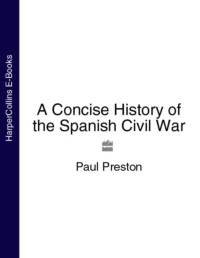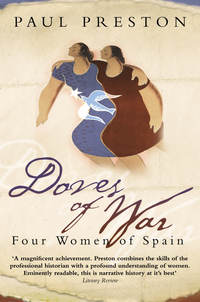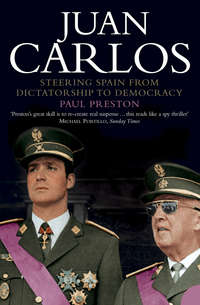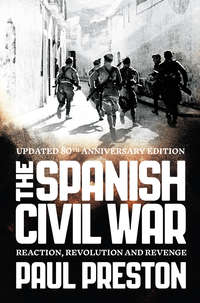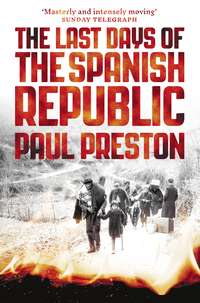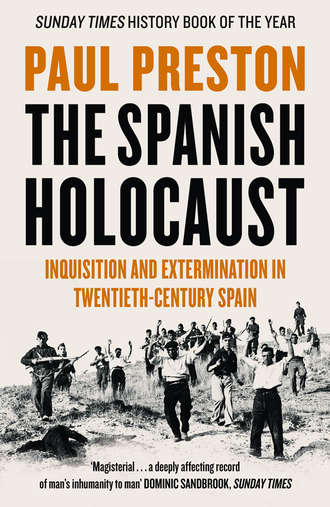
Полная версия
The Spanish Holocaust: Inquisition and Extermination in Twentieth-Century Spain
Serious investigation was not possible until after the death of Franco in 1975. When researchers began the task, they were confronted not only with the deliberate destruction of much archival material by the Francoist authorities but also with the fact that many deaths had simply been registered either falsely or not at all. In addition to the concealment of crimes by the dictatorship was the continued fear of witnesses about coming forward and the obstruction of research, especially in the provinces of Old Castile. Archival material has mysteriously disappeared and frequently local officials have refused to permit consultation of the civilian registry.8
Many executions by the military rebels were given a veneer of pseudo-legality by trials, although they were effectively little different from extra-judicial murder. Death sentences were handed out after procedures lasting minutes in which the accused were not allowed to speak.9 The deaths of those killed in what the rebels called ‘cleansing and punishment operations’ were given the flimsiest legal justification by being registered as ‘by dint of the application of the declaration of martial law’ (‘por aplicación del bando de Guerra’). This was meant to legalize the summary execution of those who resisted the military take-over. The collateral deaths of many innocent people, unarmed and not offering any resistance, were also registered in this way. Then there were the executions of those registered as killed ‘without trial’ in reference to those who were discovered harbouring a fugitive, and so were shot just on military orders. There was also a systematic effort to conceal what had happened. Prisoners were taken far from their home towns, executed and buried in unmarked mass graves.10
Finally, there is the fact that a substantial number of deaths were not registered in any way. This was the case with many of those who fled before Franco’s African columns as they headed from Seville to Madrid. As each town or village was occupied, among those killed were refugees from elsewhere. Since they carried no papers, their names or places of origin were unknown. It may never be possible to calculate the exact numbers murdered in the open fields by squads of mounted Falangists and extreme right-wing monarchists of the so-called Carlist movement. It is equally impossible to ascertain the fate of the thousands of refugees from Western Andalusia who died in the exodus after the fall of Málaga in 1937 or of those from all over Spain who had taken refuge in Barcelona only to die in the flight to the French border in 1939 or of those who committed suicide after waiting in vain for evacuation from the Mediterranean ports.
Nevertheless, the huge amount of research that has been carried out makes it possible to state that, broadly speaking, the repression by the rebels was about three times greater than that which took place in the Republican zone. The currently most reliable, yet still tentative, figure for deaths at the hands of the military rebels and their supporters is 130,199. However, it is unlikely that such deaths were fewer than 150,000 and they could well be more. Some areas have been studied only partially; others hardly at all. In several areas, which spent time in both zones, and for which the figures are known with some precision, the differences between the numbers of deaths at the hands of Republicans and at the hands of rebels are shocking. To give some examples, in Badajoz, there were 1,437 victims of the left as against 8,914 victims of the rebels; in Seville, 447 victims of the left, 12,507 victims of the rebels; in Cádiz, 97 victims of the left, 3,071 victims of the rebels; and in Huelva, 101 victims of the left, 6,019 victims of the rebels. In places where there was no Republican violence, the figures for rebel killings are almost incredible, for example Navarre, 3,280, La Rioja, 1,977. In most places where the Republican repression was the greater, like Alicante, Girona or Teruel, the differences are in the hundreds.11 The exception is Madrid. The killings throughout the war when the capital was under Republican control seem to have been nearer three times those carried out after the rebel occupation. However, precise calculation is rendered difficult by the fact that the most frequently quoted figure for the post-war repression in Madrid, of 2,663 deaths, is based on a study of those executed and buried in only one cemetery, the Almudena or Cementerio del Este.12
Although exceeded by the violence exercised by the Francoists, the repression in the Republican zone before it was stopped by the Popular Front government was nonetheless horrifying. Its scale and nature necessarily varied, with the highest figures being recorded for the largely Socialist south of Toledo and the anarchist-dominated area from the south of Zaragoza, through Teruel into western Tarragona.13 In Toledo, 3,152 rightists were killed, of whom 10 per cent were members of the clergy (nearly half of the province’s clergy).14 In Cuenca, the total deaths were 516 (of whom thirty-six, or 7 per cent of the total killed, were priests – nearly a quarter of the province’s clergy).15 The figure for deaths in Republican Catalonia, according to the exhaustive study by Josep Maria Solé i Sabaté and Joan Vilarroyo i Font, was 8,360. This figure corresponds closely to the conclusions reached by a commission created by the Generalitat de Catalunya (the Catalan regional government) in 1937. Part of the efforts of the Republican authorities to register deaths, it was led by a judge, Bertran de Quintana, and investigated all deaths behind the lines in order to instigate measures against those responsible for extra-judicial executions.16 Such a procedure would have been inconceivable in the rebel zone.
Recent scholarship, not only for Catalonia but also for most of Republican Spain, has dramatically dismantled the propagandistic allegations made by the rebels at the time. On 18 July 1938 in Burgos, Franco himself claimed that 54,000 people had been killed in Catalonia. In the same speech, he alleged that 70,000 had been murdered in Madrid and 20,000 in Valencia. On the same day, he told a reporter there had already been a total of 470,000 murders in the Republican zone.17 To prove the scale of Republican iniquity to the world, on 26 April 1940 he set up a massive state investigation, the Causa General, ‘to gather trustworthy information’ to ascertain the true scale of the crimes committed in the Republican zone. Denunciation and exaggeration were encouraged. Thus it came as a desperate disappointment to Franco when, on the basis of the information gathered, the Causa General concluded that the number of deaths was 85,940. Although inflated and including many duplications, this figure was still so far below Franco’s claims that, for over a quarter of a century, it was omitted from editions of the published résumé of the Causa General’s findings.18
A central, yet under-estimated, part of the repression carried out by the rebels – the systematic persecution of women – is not susceptible to statistical analysis. Murder, torture and rape were generalized punishments for the gender liberation embraced by many, but not all, liberal and left-wing women during the Republican period. Those who came out of prison alive suffered deep lifelong physical and psychological problems. Thousands of others were subjected to rape and other sexual abuses, the humiliation of head shaving and public soiling after the forced ingestion of castor oil. For most Republican women, there were also the terrible economic and psychological problems of having their husbands, fathers, brothers and sons murdered or forced to flee, which often saw the wives themselves arrested in efforts to get them to reveal the whereabouts of their menfolk. In contrast, despite frequent assumptions that the raping of nuns was common in Republican Spain, there was relatively little equivalent abuse of women there. That is not to say that it did not take place. The sexual molestation of around one dozen nuns and the deaths of 296, just over 1.3 per cent of the female clergy, is shocking but of a notably lower order of magnitude than the fate of women in the rebel zone.19 That is not entirely surprising given that respect for women was built into the Republic’s reforming programme.
The statistical vision of the Spanish holocaust is not only flawed, incomplete and unlikely ever to be complete. It also fails to capture the intense horror that lies behind the numbers. The account that follows includes many stories of individuals, of men, women and children from both sides. It introduces some specific but representative cases of victims and perpetrators from all over the country. It is hoped thereby to convey the suffering unleashed upon their own fellow citizens by the arrogance and brutality of the officers who rose up on 17 July 1936. They provoked a war that was unnecessary and whose consequences still reverberate bitterly in Spain today.
1

Social War Begins, 1931–1933
On 18 July 1936, on hearing of the military uprising in Morocco, an aristocratic landowner lined up the labourers on his estate to the south-west of Salamanca and shot six of them as a lesson to the others. The Conde de Alba de Yeltes, Gonzalo de Aguilera y Munro, a retired cavalry officer, joined the press service of the rebel forces during the Civil War and boasted of his crime to foreign visitors.1 Although his alleged atrocity was extreme, the sentiments behind it were not unrepresentative of the hatreds that had smouldered in the Spanish countryside over the twenty years before the military uprising of 1936. Aguilera’s cold and calculated violence reflected the belief, common among the rural upper classes, that the landless labourers were sub-human. This attitude had become common among the big landowners since a series of sporadic uprisings by hungry day-labourers in the regions of Spain dominated by huge estates (latifundios). Taking place between 1918 and 1921, a period of bitter social conflict known thereafter as the trienio bolchevique (three Bolshevik years), these insurrections had been crushed by the traditional defenders of the rural oligarchy, the Civil Guard and the army. Previously, there had been an uneasy truce within which the wretched lives of the landless day-labourers (jornaleros or braceros) were occasionally relieved by the patronizing gestures of the owners – the gift of food or a blind eye turned to rabbit poaching or to the gathering of windfall crops. The violence of the conflicts had outraged the landlords, who would never forgive the insubordination of the braceros they considered to be an inferior species. Accordingly, the paternalism which had somewhat mitigated the daily brutality of the day-labourers’ lives came to an abrupt end.
The agrarian oligarchy, in an unequal partnership with the industrial and financial bourgeoisie, was traditionally the dominant force in Spanish capitalism. Its monopoly of power began to be challenged on two sides in the course of the painful and uneven process of industrialization. The prosperity enjoyed by neutral Spain during the First World War emboldened industrialists and bankers to jostle with the great landowners for political position. However, with both menaced by a militant industrial proletariat, they soon rebuilt a defensive alliance. In August 1917, the left’s feeble revolutionary threat was bloodily smothered by the army. Thereafter, until 1923, when the army intervened again, social ferment occasionally bordered on undeclared civil war. In the south, there were the rural uprisings of the ‘three Bolshevik years’. In the north, the industrialists of Catalonia, the Basque Country and Asturias, having tried to ride the immediate post-war recession with wage-cuts and layoffs, faced violent strikes and, in Barcelona, a terrorist spiral of provocations and reprisals.
In the consequent atmosphere of uncertainty and anxiety, there was a ready middle-class audience for the notion long since disseminated by extreme right-wing Catholics that a secret alliance of Jews, Freemasons and the Communist Third International was conspiring to destroy Christian Europe, with Spain as a principal target. In Catholic Spain, the idea that there was an evil Jewish conspiracy to destroy Christianity had emerged in the early Middle Ages. In the nineteenth century, the Spanish extreme right resurrected it to discredit the liberals whom they viewed as responsible for social changes that were damaging their interests. In this paranoid fantasy, Freemasons were smeared as tools of the Jews (of whom there were virtually none) in a sinister plot to establish Jewish tyranny over the Christian world.
As the nineteenth century drew to a close, such views were expressed with ever increasing vehemence. They were a response to the kaleidoscopic processes of rapid economic growth, social dislocation, regionalist agitations, a bourgeois reform movement and the emergence of trade unions and left-wing parties. An explanation for the destabilization of Spanish society and the attendant collapse of the relative certainties of a predominantly rural society was found in a deeply alarming, yet somehow comforting, assertion that shifted the blame on to an identifiable and foreign enemy. It was alleged that, using Freemasons as their willing intermediaries, the Jews controlled the economy, politics, the press, literature and the entertainment world through which they propagated immorality and the brutalization of the masses. Such views had long been peddled by El Siglo Futuro, the daily newspaper of the deeply reactionary Carlist Traditionalist Communion. In 1912, the National Anti-Masonic and Anti-Semitic League had been founded by José Ignacio de Urbina with the support of twenty-two Spanish bishops. The Bishop of Almería wrote that ‘everything is ready for the decisive battle that must be unleashed between the children of light and the children of darkness, between Catholicism and Judaism, between Christ and the Devil’.2 That there was never any hard evidence was put down to the cleverness and colossal power of the enemy, evil itself.
In Spain, as in other European countries, anti-Semitism had reached even greater intensity after 1917. It was taken as axiomatic that socialism was a Jewish creation and that the Russian revolution had been financed by Jewish capital, an idea given a spurious credibility by the Jewish origins of prominent Bolsheviks such as Trotsky, Martov and Dan. Spain’s middle and upper classes were chilled, and outraged, by the various revolutionary upheavals that threatened them between 1917 and 1923. The fears of the elite were somewhat calmed in September 1923, when the army intervened again and a dictatorship was established by General Miguel Primo de Rivera. As Captain General of Barcelona, Primo de Rivera was the ally of Catalan textile barons and understood their sense of being under threat from their anarchist workforce. Moreover, coming from a substantial landowning family in Jérez, he also appreciated the fears of the big southern landowners or latifundistas. He was thus the ideal praetorian defender of the reactionary coalition of industrialists and landowners consolidated after 1917. While Primo de Rivera remained in power, he offered security to the middle and upper classes. Nevertheless, his ideologues worked hard to build the notion that in Spain two bitterly hostile social, political and, indeed, moral groupings were locked in a fight to the death. Specifically, in a pre-echo of the function that they would also fulfil for Franco, these propagandists stressed the dangers faced from Jews, Freemasons and leftists.
These ideas essentially delegitimized the entire spectrum of the left, from middle-class liberal democrats, via Socialists and regional nationalists, to anarchists and Communists. This was done by blurring distinctions between them and by denying their right to be considered Spanish. The denunciations of this ‘anti-Spain’ were publicized through the right-wing press and the regime’s single party, the Unión Patriótica, as well as through civic organizations and the education system. These notions served to generate satisfaction with the dictatorship as a bulwark against the perceived Bolshevik threat. Starting from the premise that the world was divided into ‘national alliances and Soviet alliances’, the influential right-wing poet José María Pemán declared that ‘the time has come for Spanish society to choose between Jesus and Barabbas’. He claimed that the masses were ‘either Christian or anarchic and destructive’ and the nation was divided between an anti-Spain made up of everything that was heterodox and foreign and the real Spain of traditional religious and monarchical values.3
Another senior propagandist of the Primo de Rivera regime, José Pemartín, linked, like his cousin Pemán, to the extreme right in Seville, also believed that Spain was under attack by an international conspiracy masterminded by Freemasonry, ‘the eternal enemy of all the world’s governments of order’. He dismissed the left, in generalized terms, as ‘the dogmatists deluded by what they think are modern, democratic and European ideas, universal suffrage, the sovereign parliament, etc. They are beyond redemption. They are made mentally ill by the worst of tyrannies, ideocracy or the tyranny of certain ideas.’ It was the duty of the army to defend Spain against these attacks.4
Despite his temporary success in anaesthetizing the anxieties of the middle and ruling classes, Primo de Rivera’s dictatorship did not last. His benevolent attempt to temper authoritarianism with paternalism inadvertently alienated landowners, industrialists, the Church hierarchy and some of the elite officer corps of the army. Most dramatically, his attempts to reform military promotion procedures ensured that the army would stand aside when a great electoral coalition of Socialists and middle-class Republicans swept to power on 14 April 1931. After the dictator’s departure in January 1930, one of the first to take up the defence of establishment interests was Dr José María Albiñana, an eccentric Valencian neurologist and frenetic admirer of Primo de Rivera.
The author of more than twenty novels and books on neurasthenia, religion, the history and philosophy of medicine and Spanish politics, and a number of mildly imperialist works about Mexico, Albiñana was convinced that there was a secret alliance working in foreign obscurity in order to destroy Spain. In February 1930, he distributed tens of thousands of copies of his Manifiesto por el Honor de España. In it, he had declared that ‘there exists a Masonic Soviet which dishonours Spain in the eyes of the world by reviving the black legend and other infamies forged by the eternal hidden enemies of our fatherland. This Soviet, made up of heartless persons, is backed by spiteful politicians who, to avenge offences against themselves, go abroad to vomit insults against Spain’. This was a reference to the Republicans exiled by the dictatorship. Two months later, he launched his ‘exclusively Spanish Nationalist Party’ whose objective was to ‘annihilate the internal enemies of the fatherland’. A fascist image was provided by its blue-shirted, Roman-saluting Legionaries of Spain, a ‘citizen volunteer force to act directly, explosively and expeditiously against any initiative which attacks or diminishes the prestige of the fatherland’.5
Albiñana was merely one of the first to argue that the fall of the monarchy was the first step in the Jewish–Masonic–Bolshevik conspiracy to take over Spain. Such ideas would feed the extreme rightist paranoia that met the establishment of the Second Republic. The passing of political power to the Socialist Party (PSOE – Partido Socialista Obrero Español) and its urban middle-class allies, the lawyers and intellectuals of the various Republican parties, sent shivers of horror through right-wing Spain. The Republican–Socialist coalition intended to use its suddenly acquired share of state power to implement a far-reaching programme to create a modern Spain by destroying the reactionary influence of the Church, eradicating militarism and improving the immediate conditions of the wretched day-labourers with agrarian reform.
This huge agenda inevitably raised the expectations of the urban and rural proletariats while provoking the fear and the determined enmity of the Church, the armed forces and the landowning and industrial oligarchies. The passage from the hatreds of 1917 –23 to the widespread violence that engulfed Spain after 1936 was long and complex but it began to speed up dramatically in the spring of 1931. The fears and hatreds of the rich found, as always, their first line of defence in the Civil Guard. However, as landowners blocked attempts at reform, the frustrated expectations of hungry day-labourers could be contained only by increasing brutality.
Many on the right took the establishment of the Republic as proof that Spain was the second front in the war against world revolution – a notion fed by numerous clashes between the forces of order and workers of the Confederación Nacional del Trabajo (CNT), the anarchist union. Resolute action against the extreme left by the Minister of the Interior, Miguel Maura, did not deter the Carlist newspaper El Siglo Futuro from attacking the government and claiming that progressive Republican legislation was ordered from abroad. It declared in June 1931 that three of the most conservative ministers, the premier, Niceto Alcalá Zamora, Miguel Maura and the Minister of Justice, Fernando de los Ríos Urruti, were Jews and that the Republic itself had been brought about as a result of a Jewish conspiracy. The more moderate Catholic mass-circulation daily El Debate referred to de los Ríos as ‘the rabbi’. The Editorial Católica, which owned an influential chain of newspapers including El Debate, soon began to publish the virulently anti-Semitic and anti-Masonic magazines Gracia y Justicia and Los Hijos del Pueblo. The editor of the scurrilously satirical Gracia y Justicia was Manuel Delgado Barreto, a one-time collaborator of the dictator General Primo de Rivera, a friend of his son José Antonio and an early sponsor of the Falange. It would reach a weekly circulation of 200,000 copies.6
The Republic would face violent resistance not only from the extreme right but also from the extreme left. The anarcho-syndicalist CNT recognized that many of its militants had voted for the Republican–Socialist coalition in the municipal elections of 12 April and that its arrival had raised the people’s hopes. As one leading anarchist put it, they were ‘like children with new shoes’. The CNT leadership, however, expecting the Republic to change nothing, aspired merely to propagate its revolutionary objectives and to pursue its fierce rivalry with the Socialist Unión General de Trabajadores (UGT), which it regarded as a scab union because of its collaboration with the Primo de Rivera regime. In a period of mass unemployment, with large numbers of migrant workers returning from overseas and unskilled construction workers left without work by the ending of the great public works projects of the dictatorship, the labour market was potentially explosive. This was a situation that would be exploited by the hard-line anarchists of the Federación Anarquista Ibérica (FAI) who argued that the Republic, like the monarchy, was just an instrument of the bourgeoisie. The brief honeymoon period came to an end when CNT–FAI demonstrations on 1 May were repressed violently by the forces of order.7
In late May, a group of nearly one thousand strikers from the port of Pasajes descended on San Sebastián with the apparent intention of looting the wealthy shopping districts. Having been warned in advance, the Minister of the Interior, Miguel Maura, deployed the Civil Guard at the entrance to the city. They repelled the attack at the cost of eight dead and many wounded. Then, in early July, the CNT launched a nationwide strike in the telephone system, largely as a challenge to the government. It was defeated by harsh police measures and strike-breaking by workers of the Socialist UGT who refused to join the CNT in what they saw as a sterile struggle. The Director General of Security, the sleek and portly Ángel Galarza of the Radical-Socialist Party, ordered that anyone seen trying to damage the installations of the telephone company should be shot. Maura and Galarza were understandably trying to maintain the confidence of the middle classes. Inevitably, their stance consolidated the violent hostility of the CNT towards both the Republic and the UGT.8


